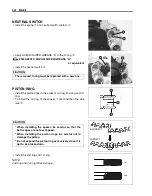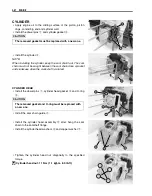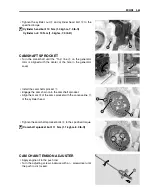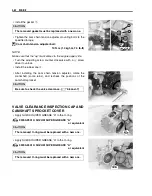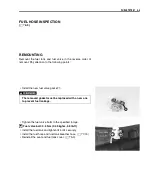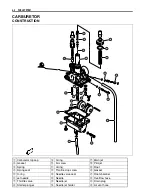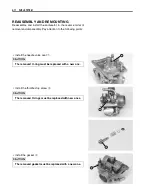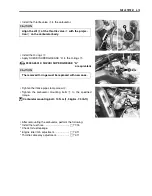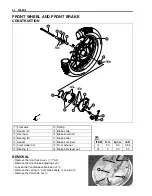
4-9 FUEL SYSTEM
AIR SCREW REMOVAL
Because harsh cleaning solvents can damage the O-ring seals
in the pilot system, the pilot system components should be
removed before cleaning.
• Use a 1/8
″
size drill bit with a drill-stop to remove the air
screw plug. Set the drill-stop 6 mm from the end of the bit to
prevent drilling into the air screw. Carefully drill through the
plug.
• Thread a self-tapping sheet metal screw into the plug. Pull on
the screw head with pliers to remove the plug. Carefully clean
any metal shavings from the area.
• Slowly turn the air screw in clockwise and count the number
of turns until the screw is lightly seated. Make a note of how
many turns were made so the screw can be reset correctly
after cleaning.
• Remove the air screw with the spring, washer, and O-ring.
• After cleaning reinstall the air screw to the original setting by
turning the screw in until it lightly seats, and then backing it
out the same number of turns counted during disassembly.
• Install new plug by tapping it into place with a punch.
CLEANING
#
• Clean all jets with a spray-type carburetor cleaner and dry
them with compressed air.
• Clean all circuits of the carburetor thoroughly – not just the
perceived problem area. Clean the circuits in the carburetor
body with a spray-type cleaner and allow each circuit to soak,
if necessary, to loosen dirt and varnish. Blow the body with
compressed air.
Drill-stop
Plug
Carburetor
body
Air screw
Some carburetor cleaning chemicals, especially
dip-type soaking solutions, are very corrosive and
must be handled carefully. Always follow the chemical
manufacturer’s instructions on proper use, handling
and storage.
Do not use a wire to clean the jets or passageways. A
wire can damage the jets and passageways. If the
components cannot be cleaned with a spray-type
cleaner, it may be necessary to use a dip-type clean-
ing solution and allow them to soak. Always follow the
chemical manufacturer’s instructions for proper use
and cleaning of the carburetor components.

